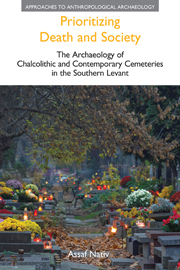 Prioritizing Death and Society
Prioritizing Death and Society Book contents
- Frontmatter
- Dedication
- Contents
- List of figures
- List of tables
- Acknowledgements
- Part I Introduction
- 1 Introduction
- 2 Binary oppositions, logical gaps and thick descriptions
- Part II Chalcolithic cemeteries
- Part III Contemporary cemeteries
- Part IV Conclusion
- Appendix: Gazetteers of cemeteries
- Notes
- Bibliography
- Index
2 - Binary oppositions, logical gaps and thick descriptions
from Part I - Introduction
- Frontmatter
- Dedication
- Contents
- List of figures
- List of tables
- Acknowledgements
- Part I Introduction
- 1 Introduction
- 2 Binary oppositions, logical gaps and thick descriptions
- Part II Chalcolithic cemeteries
- Part III Contemporary cemeteries
- Part IV Conclusion
- Appendix: Gazetteers of cemeteries
- Notes
- Bibliography
- Index
Summary
This book proposes a comparative analysis of distinct cultural systems. If it differs from other comparative studies, it is in its lack of contextual justification for the choice of objects for comparison; they are neither contemporaneous nor do they represent a continuous development. Moreover, the comparative effort is to a considerable extent oriented towards the elucidation of qualitative difference. In this it is set apart from a range of more common aims, generally oriented to the establishment of links: statistical evaluation of theories, measurement of variability, identification of material correlates for social features (e.g. gender roles, social ranking) and substantiating correlations between variables and evolutionary processes (see Peregeine 2004).
These features, I feel, set this study sufficiently apart from most others to warrant justification and an explicit account of its theoretical reasoning. Four elementary concepts will be discussed in this regard: binary opposition, logical gap, cultural arbitrariness and thick description. Together these concepts will demonstrate the efficacy, relevance and justification of the present research design; they will also clarify some important tenets of the approach in question. Finally, several examples will be offered to further substantiate the claims.
Binary oppositions
The concept of the binary opposition was developed in the field of structural linguistics and stems from the Saussurian tenet that the meaning of a word or a sign is a function of its opposition to others — that is, every term is conceived through what the others are not.
- Type
- Chapter
- Information
- Prioritizing Death and SocietyThe Archaeology of Chalcolithic and Contemporary Cemeteries in the Southern Levant, pp. 13 - 22Publisher: Acumen PublishingPrint publication year: 2013


